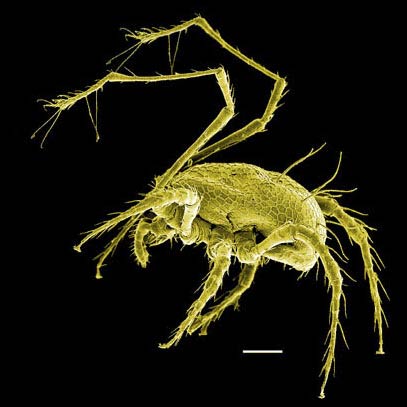Taxonomic Position
Cohort Gamasina
Subcohort Epicriiae
Family: Epicriidae Berlese
Epicrius G. Canestrini & Fanzago, Berlesiana Turk, Adenoepicrius Moraza, Neoepicrius Moraza & Johnson
Diagnostic characters:
-
Dome-shaped holodorsal shield with reticulate-tuberculate ornamentation, a pair of large gland openings, and bearing 15-34 pairs of setae
-
Peritremes absent
-
Tarsus I with elongate knobbed setae
-
Sternal setae st1 off sternal shield, usually on small platelets (jugularia) or in soft cuticle
-
Male genital opening mid-intercoxal.

Similar taxa. Species of Epicriopsis (Ameroseiidae) have claws and empodium on legs I and well developed peritremes. The presence of peritremes also serves to distinguish species of Podocinidae, and along with divided dorsal shields, some Ologamasidae (Euepicrius), and some Ascidae (Antennoseius) that have convergent elongate legs I and polygonal idiosomal ornamentation.
Diagnosis:
1. Yellow, tan or dark red brown mites, with a hypotrichous, domed holodorsal shield covered in polygonal reticulum of tubercles and bearing a pair of large dorsolateral gland openings. First pair of sternal setae on jugularia or in soft cuticle; st2-3 on common sclerite; st4 in soft cuticle or on platelets. Genital shield axe- to tongue-shape, with 1-2 pairs of setae. Inguinal glands on small platelets behind coxae IV. Anal opening with 2 valves in small anal shield with 3-5 setae. Peritremes absent or minute. Tarsus I without claws, usually with slender clubbed setae; tibia I sometimes with a minutely clubbed seta. Palp genu with 6 setae; palp apotele with 2 or 3 tines. Epistome denticulate; hypostomal setae in triangular array; hypostomal groove broad, with denticles; corniculi slender, horn-like. Chelicerae chelate-dentate; pilus dentilis setiform; cheliceral setaa elongate, laterad and parallel to digits. Male genital opening on intercoxal shield, valve with or without a pair of setae; neither chelicerae nor legs obviously modified for sperm transfer.
Key to Genera
1. Tarsi II-IV with an intercalary sclerite between the basitarsus and telotarsus that bears setae ad3, pd3; palp apotele 3-tined; dorsal shield with 34 pairs of setae (19 podonotal, 15 opisthosomal).......................... 2
- Tarsi II-IV without a seta bearing intercalary sclerite between the basitarsus and telotarsus; palp apotele 2-tined; dorsal shield with only 15 pairs of setae (10 podonotal, 5 opisthonotal); Western North America ............................ Neoepicrius Moraza & Johnson
2. Genitoventral shield expanded behind coxae IV and capturing a gland and setae ZV1; palp tarsus with 15 setae; Holacrtic..................................... Epicrius C&F
- Genital or genitoventral shield not expanded; palp tarsus with 14 setae............................... 3
3. Dorsal shield with short pilosities; st4 on metasternal shield; tarsus I with 4 clubbed macrosetae; Eastern North America.................................................................. Adenoepicrius Moraza
- Most dorsal shield setae stout, strongly barbed with long pilosities; st4 in soft cuticle; tarsus I with 3 clubbed macrosetae; Palearctic................................................. Berlesiana Turk
References
Evans EO.
1955. A revision of the family
Epicriidae (Acarina: Mesostigmata). Bulletin
of the British Museum (Natural History) [Zool.] 3: 171-200.
Gilyarov MS & Bregatova NG (eds) 1977.
Handbook for the Identification of Soil-inhabiting Mites,
Mesostigmata. Zoological Institute
of the Academy of Sciences: Petrograd [In Russian]
Johnston DE.
1982. Mesostigmata. In: Parker, S.P. (ed.) Synopsis and classification of living
organisms. McGraw-Hill, New York, p.
112-116.
Krantz GW.
1978. A Manual of Acarology. OSU Bookstores: Corvallis.
Krantz, GW & Ainscough, B. 1990. Mesostigmata. pp. 583-665, in DL Dindal (ed) Soil Biology Guide. John Wiley & Sons: Brisbane.
Moraza ML. 2005. A new genus and species of Epicriidae (Acari: Mesostigmata) from eastern North America. Canadian Entomologist 137: 539-550.
Moraza ML & Johnston D. 2004. Neoepicrius, gen. n. from Western North America (Acari: Mesostigmata: Epicriidae). Acarologia 44: 195-207.